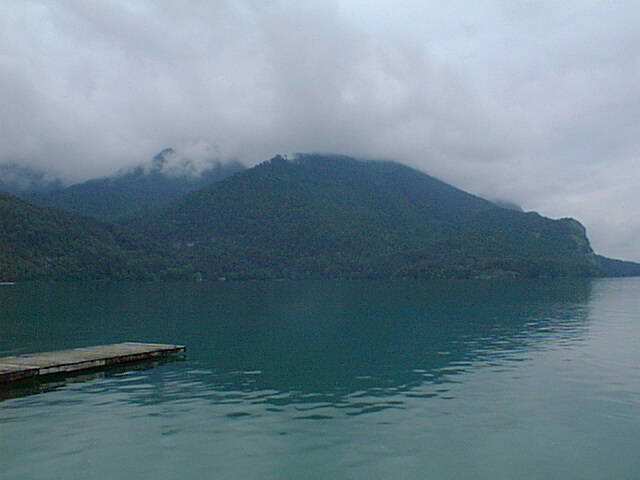
This morning we got up early to drive about 30 km (20 miles) outside of Salzburg to St. Gilgen, to sing during the 10 a.m. Mass at the church of the same name. The weather was pretty much like yesterday, with light, intermittent rain most of the day. The town of St. Gilgen is on the shores of the Wolfgangsee ("see" means "lake" in German; the word for "sea" is "meer"); I hope the photo below, looking across the lake, has enough resolution to show you the beautiful way that the mountains around the town reached up into the low cloud ceiling!

The church of St. Gilgen is being restored, and is covered with scaffolding; also, the buildings adjacent to it are pretty close, so I couldn't get a good clear photo of it. The photo below shows a painting on one outside wall; the label, "St. Aegydius", is the Latin form of the name of the saint called Gilgen in German. I couldn't figure it out either. The deer in the painting, according to legend, sustained him in the woods with her milk; I understand he is a popular figure throughout central Europe.
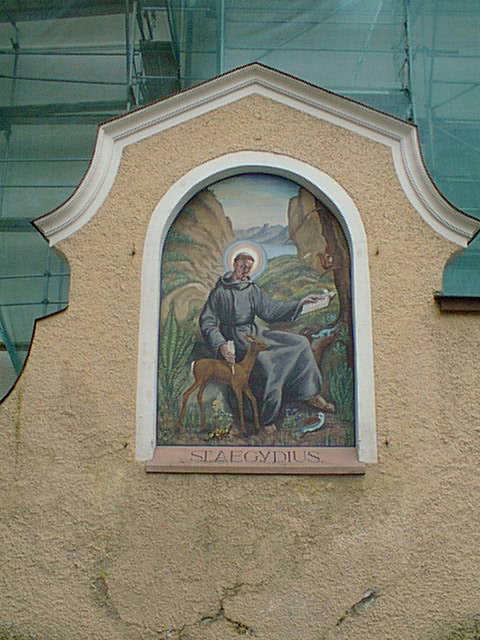
The service was very musical, much more so than the one we participated in last Sunday in Florence. Not only did we sing more songs (the Kyrie, Sanctus, and Agnus Dei from Rutter's Requiem, plus a couple of anthems, plus prelude and postlude at the organ by Lee Lasseter), but also the priest sang much of the liturgy and the church's regular organist led the many congregational responses with the organ and his enviable baritone voice. Also, something I have not encountered at the (relatively few) other Catholic masses I have attended was that the altar boys rang small bells inside and the bellringer rang the main bell outside as the priest elevated the Host (though Ken Sanson says this is quite normal in traditional Masses).
After the Mass, we stayed in the town of St. Gilgen for about an hour (long enough for a few photos or an apfelstrudel), then returned to our hotel, whereupon we scattered to the four winds since the rest of the day was unscheduled. Most of us, of course, walked the short distance into the old part of Salzburg to have a look around.
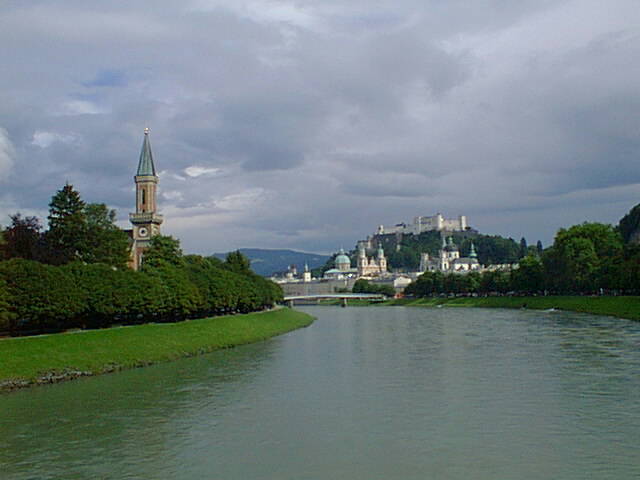
This is the view from a bridge just up the Salzach, or Salt River, from our hotel. Actually the river is perfectly good fresh water; it's named for the fact that the precious salt that gave Salzburg its name (and its early source of wealth) was floated in barrels down this river. Near river level on the right you can see what appear to be two large churches; the one on the left with the large dome is the main city cathedral, and on the right is actually two or three churches, one in front of another. On the hill overlooking the town is the largest intact (because it was never conquered) fortress in central Europe, the Hohensalzburg Fortress.
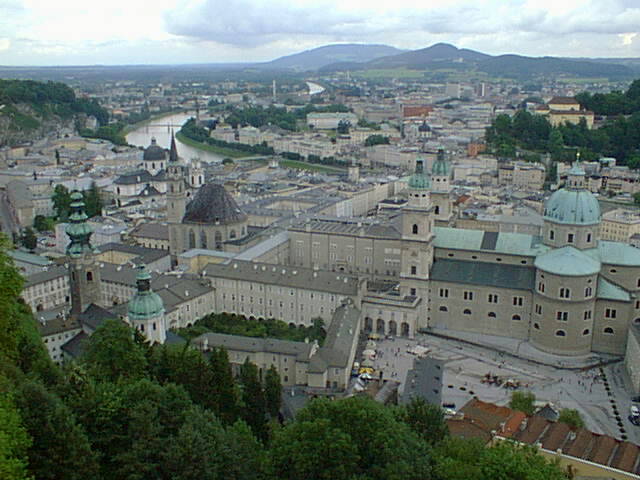
A funicular railway (or a steep half-hour hike!) takes you up to the fortress, from which this photo of the city was shot; I ran into many members of our group up there. A lot of the group are going back tonight for the chamber music concert that is held in the formal halls of the fortress (it's not all armories, storehouses, and torture chambers!).The fortress was started in the late 11th century, and the last major expansion occurred in the late 17th century; it's a whole compact city up there, into which pretty much the entire population could retreat in case of siege. Its walls and towers were strengthened and extended several times, and I guess they kept one step ahead of advances in weaponry, since as I noted above the fortress was never breached.
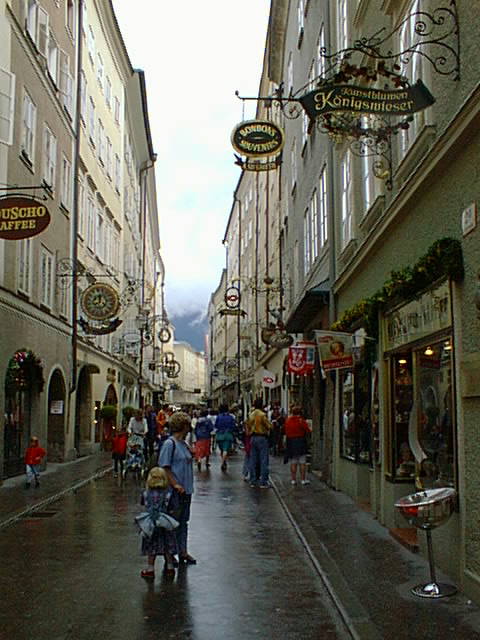
In the city are many interesting locations besides the fortress and churches, for example the house where Mozart was born and the one he lived in from the age of 17 until he left for Vienna at 25. The above photo is of the Getreidegasse, a long-established shopping area (now restricted to pedestrians) where almost all of the shops are identified by ornate ironwork signs. Even McDonald's had one!
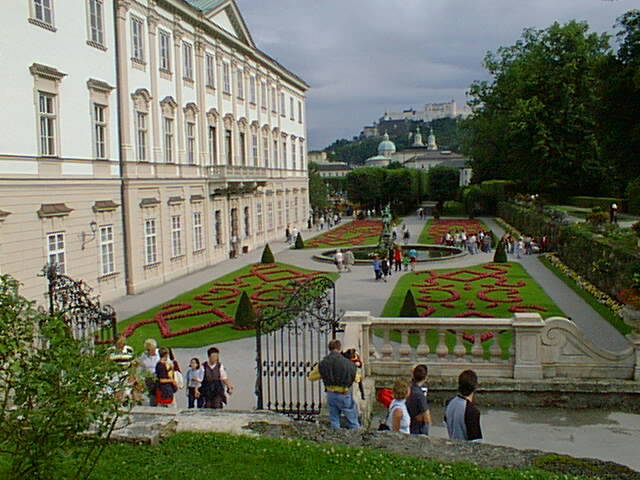
This is a view toward the old city from the other side of the river, at the Mirabell Palace and Gardens, dating to the late 17th century. Somewhere in the gardens are an entrance and a fountain that figured prominently in one scene of the movie of "The Sound of Music", and they were pointed out by our guide on our tour yesterday evening, but I didn't manage to relocate them today.
This is our last day in Austria; tomorrow we change our schillings for marks as we head to Munich. We won't have much free time at all in Munich itself, since on Monday we arrive kind of late, Tuesday we head out to Neuschwanstein Castle and our last singing engagement of the tour at the Wieskirche in Steingaden, and Wednesday afternoon we fly home. I have to think about which of the places I want to revisit of those with which I became acquainted when I was on loan to the Max Planck Institute there for three months in 1994...
 To
Monday, 12 July 1999
To
Monday, 12 July 1999 Back
to choir tour itinerary
Back
to choir tour itinerary Back
to choir tour home page
Back
to choir tour home pagenew 11 July 1999, updated 13 July 1999